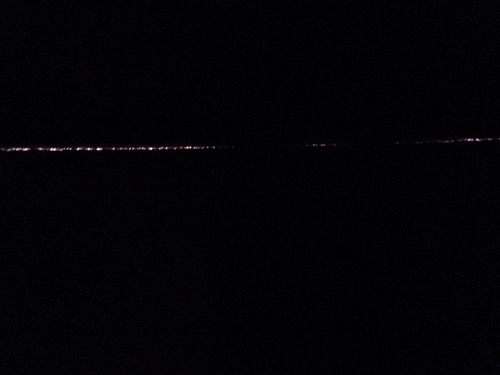TransCanada, the company currently constructing the southern segment of the Keystone XL pipeline, claims to use “top quality steel and welding techniques” throughout its pipeline network.
Last week, however, activists fighting the construction of the pipeline released images of what they claim are improperly welded pipeline seams. The photos were released by Keystone XL blockader Ramsey Sprague at the Pipe Tech Americas 2013 conference in Texas and were taken by blockader Isabel Brooks.
Brooks took the photographs from inside a pipe segment on December 3, 2012 to document what they say was daylight pouring through weld seams between segments. “All of us looked at it,” Brooks told DeSmog, speaking of the defective seam, “and it was clear light was coming in from the outside…It was definitely clear what it was.”
An hour after the protesters were extracted from the pipe segment, says Brooks, it was in the ground. “[Other protestors] told me that it was in the ground that day and buried. So they didn’t test it again,” she said. “I know exactly the piece of pipe that it’s at, so if we were to dig it up I know it would be right there and as clear as that day.”
These two images from inside the pipe were released by Sprague last week:
There are different types of weld marks, Brooks explained: “there is a spiral weld on the inside and then there is a circumference weld that goes around each segment of pipe…at around 25 feet, along each segment of pipe, there is the weld that connects two pieces flushly.”
It was along the connecting seam between two segments of pipe that Brooks first noticed the outside light. “We were sleeping for a while after we had locked ourselves inside of the pipe. I was about 25 feet in and we all knew this. We were tired and were waiting for the police to arrive and we settled down and tried to get some rest. I, at one point, woke up and it was dark inside…but it was after sunrise and this circle of light became present around me.”
“I was right underneath it which is the bizarre part – that I just happened to lie down [and] it was right around me…and it was like little pokes, little dots all around…Some areas had more light coming through and some didn’t but it was a clear circle around me.”
“When I saw that I told Matt about it, another person who was with me, and I told Glen as well. We had a little conversation about it, [saying], ‘Wow. Crazy. Are you sure? That would be a really big thing, if that was the case.”
“I’m a photographer so I can speak to the lighting,” said Brooks. “I turned the aperture up and turned the shutter speed down really low…I know that it’s very ambiguous. It’s not the best image at all and if I had a camera that could have taken a better image it would have been preferable or even if the light was better because it was a foggy, overcast day.”
But still, said Brooks, “it was definitely clear what it was.”
“I just had to point and shoot and as anyone who saw images of the pipe it’s completely dark inside unless you use a flash but the flash wouldn’t have worked obviously because the light was coming in from the outside.”
Brooks, along with her two companions, Matt Almonte and Glen Collins, were arrested at the scene and spent 24 days in jail. During that time, Brooks was unsure of the fate of the image, which remained in police custody.
“I was sitting on the information for a while,” she said, “because I didn’t want to put it out over the phone and I didn’t want to send hope to my friends [because] I didn’t know if the camera was going to make it through the jail system. I had planned on taking the memory card out and taking it with me but they took it from me and put it with my property. I was excited when I saw it and…I immediately flipped through and saw this image and said, ‘oh my god, here is it, here we go. This is the big thing.’”
The images have reignited concerns over TransCanada’s poor safety practices exposed by company whistleblower Evan Vokes in May 2012.
Vokes, a former TransCanada metallurgical engineer, said the company’s substandard practices and failure to meet welding regulations led him to file a formal complaint with Canada’s National Energy Board (NEB). Vokes was moved to report TransCanada’s non-compliance to the federal body after officials with the company refused to act on his complaints.
“I wrote a series of emails to a series of project managers saying, ‘We can’t do this practice, we can’t do this practice, we can’t do this practice,’” Vokes told the CBC. “And I received increasingly pressured emails about how things were OK to do it that way.”
TransCanada fired Vokes on May 8, 2012. Less than 6 months later, the NEB issued a public letter to TransCanada, stating “many of the allegations of regulatory non-compliance identified by the complainant were verified by TransCanada’s internal audit.”
The NEB added it was “concerned by TransCanada’s non-compliance with NEB regulations, as well as its own internal management systems and procedures.”
Vokes also observed a serious conflict of interest when TransCanada pipeline contractors hired their own pipeline inspectors, despite federal regulations making independent inspection mandatory.
“In pipelining, there is a huge amount of stress for a very thin pipe,” he told the CBC. “You certainly should be paying attention to what is wrong with your pipe, making sure nothing happens to it, and there are no injurious defects to your pipe as it is being put into the ground.”
The current construction of the southern leg of the Keystone XL is being handled by Michels Pipeline Construction, a contractor for TransCanada.
Isabel Brooks said Michels should be held responsible for the faulty seam. “Whomever does the welding of the northern half of the Gulf coast line, they are the ones who had this slip up. It was definitely something that was done on land…When they put this segment togther that’s where the issue comes from.”
Subscribe to our newsletter
Stay up to date with DeSmog news and alerts








